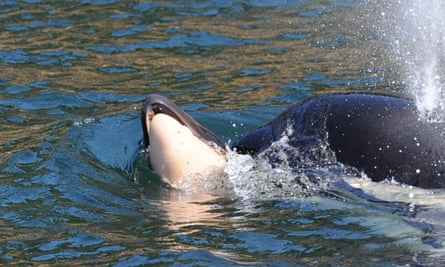A grieving mother orca near Vancouver Island has been carrying her dead calf for four days, after refusing to leave her baby behind when the rest of her pod left.
The mother killer whale, named J35 by researchers, gave birth Tuesday in what was initially a hopeful moment. Mother and female calf were seen swimming together that morning near Victoria, British Columbia, according to the Washington state-based Center for Whale Research.
Within hours, though, the calf had died and J35’s pod had moved out of the area.
“The baby’s carcass was sinking and being repeatedly retrieved by the mother, who was supporting it on her forehead and pushing it in choppy seas,” said the Center for Whale Research in a statement. “The mother continued supporting and pushing the dead baby whale throughout the day until at least sunset.”
J35 was still holding up her calf as of Friday morning, Lisa Moorby, a Center for Whale Research spokesperson, said. Orcas and dolphins have been known to swim their dead calves for as long as a week.
The calf’s death highlights the larger tragedy facing orcas and the ecosystem they rely on in the Salish Sea, a waterway stretching from south of Seattle to north of Vancouver.

The Center for Whale Research, which monitors the whale population for the American and Canadian governments, reports that three years have passed since an orca residing in the area has birthed a surviving calf. The survival rate in the past two decades has been 75%. Only 75 killer whales in the endangered group, known as southern resident orcas, remain.
The orcas’ decline is linked to the failure of another iconic Pacific north-west species, the Chinook salmon. Like the southern resident orcas, several Chinook stocks are listed under the US Endangered Species Act. Orcas have struggled to feed as stocks have declined.
This month, the National Oceanic and Atmospheric Administration scientists and Washington state fisheries officials announced they had reoriented salmon recovery efforts to save the orcas.
“The goal is to apply what we’ve learned to protect and recover the whales, but we’re always learning more,” Michael Ford of Noaa Fisheries’ Northwest Fisheries Science Center said recently.
Ken Balcomb, founder of the Center for Whale Research, said orcas required wild salmon, not hatchery-raised fish grown to prop up the commercial and recreational fisheries.
“The larger environmental question reflected in the J35 story is that both the USA and Canada must redouble efforts to restore wild salmon … for a food supply for the [southern resident killer whales] in this region,” Balcomb said Friday. “Hatchery fish are inferior and non-sustainable, and farm fish of course are not available for whale consumption.”
Killer whales are long-lived – one Seattle-area orca known as Granny is believed to have lived 106 years before her death in 2016 – but the remaining southern resident orcas must start reproducing again before they grow too old to calve. If they don’t, the ageing pods will dwindle for decades before the last orca finally slips beneath the waves.
